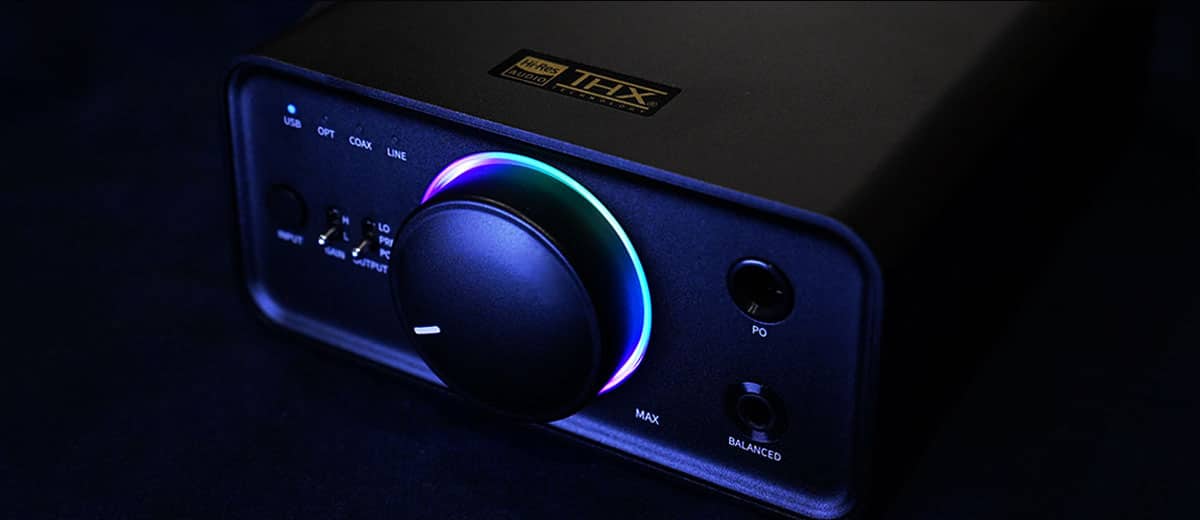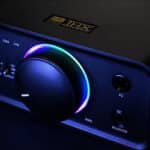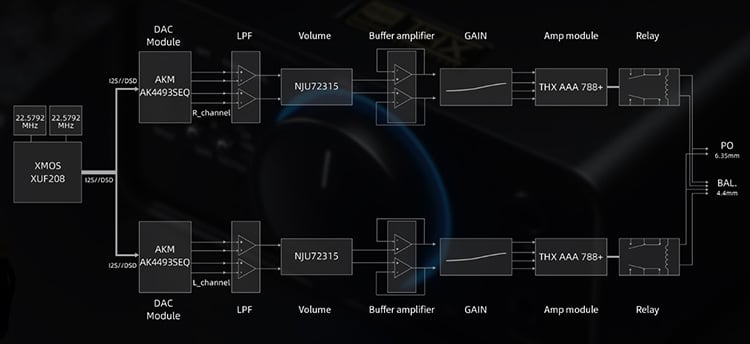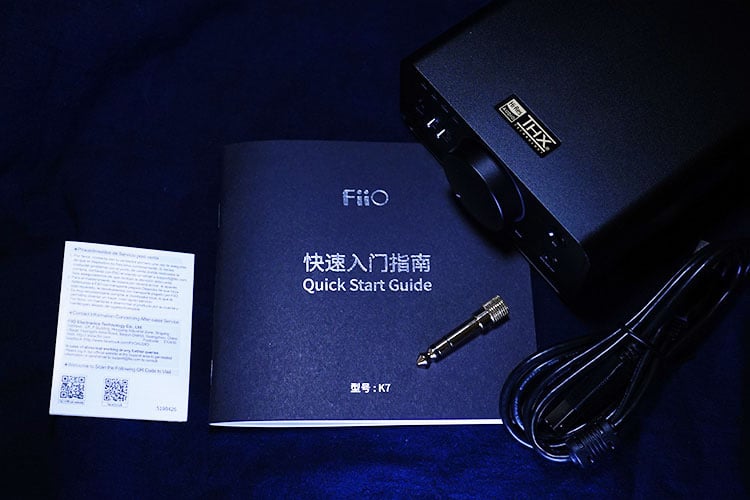In this feature, we review the new FiiO K7, which is an affordable desktop dual AK4493s DAC and THX AAA 788+ balanced headphone amplifier. It is priced at $199.99.
Disclaimer: This was sent to us as a sample for our honest opinion. Headfonics is an independent website with no affiliate links or services. We thank FiiO for its support.
You can click here to learn more about the FiiO gear we have previously highlighted on Headfonics.
Note, that this post follows our latest scoring guidelines which you can read up on here.
The FiiO K7 decoder and amplifier and from afar it looks like a twin brother of the K5PRO ESS at first glance.
However, when looking into the specifications the amping circuitry has a high resemblance to the K9 Pro ESS, featuring the same 6-stage configuration and THX AAA 788+.
The K7 is capable of outputting 2W max on a 4.4mm balanced connection and an affordable price of $199 USD. That is even cheaper than when the K5 Pro ESS first came out, which makes it very appealing. We can’t wait to hear how it performs!
Tech Highlights
DAC
Like the K9 Pro ESS, the K7 adopts a fully balanced architecture to achieve better crosstalk performance and boost the output power to a much higher extent.
The K7 rides on XMOS XUF208 with two crystal oscillators and two pieces of Asahi Kasei Microdevice’s AK4493 SEQ chipsets to offer DSD256, 32bit/384kHz decoding.
From my experience the AK4493 SEQ has a good hint of warmth in the mids which could have good synergy with clean and powerful amping stages, it isn’t the best chipset out there but at $199 it is a decent choice.
Amplification
No matter whether you are using the K7 as a decoder or an amplifier, the audio signal is processed through 6 stages that include low pass filtering, NJU72315 volume control, buffering, gain, and THX AAA 788+ amping stages.
There are LDO regulators for each stage of amplification, also relay components before the output as a protection measure to keep your headphones safe from destructive voltage swings.
The K7 can deliver 2000mW with a 32ohm load and achieved <0.00028% THD+N distortion at 1kHz with a 32oΩ load, much higher than straight out of the DAC chips.
The SNR has been enhanced by 5dB than the K5 Pro ESS to 123dB which is quite impressive on paper.
Preamp
The K7 doubles as a pre-amp with RCA line-in connectivity. It works swiftly as a volume controller for active speakers or as a decoder for a power amp.
When compared to the previous generation product the K7’s Lineout is further enhanced measuring >120dB in SNR and <0.0005% THD+N, which is quite a big step up from the K5PRO ESS’s performance.
ADC Volume Control
Although the K7 has a traditional knob design it is coupled with a special mechanism to deter imbalance issues with sensitive gear at low volume and allow the volume to be finely tuned.
This implementation is highly effective in practice and there is good flexibility pairing with various IEMs and headphones of low impedance ratings.
Design
The K series from FiiO shares the same modern design language so the K7 comes in an elongated housing that has a strong resemblance to the K5PRO ESS.
On top of the K7, you can see the THX label and high-res logo standing out, which makes it look more professional.
With a balanced implementation, FiiO still manages to put the K7 within a fantastically small 120*168*55mm package, which is much more portable than the K9 Pro ESS.
Firing up the K7 you can see the volume knob glowing with the RGB spectrum, which looks perfect with gaming keyboards and brushes up the rather plain outlook to feel much cooler.
When in use the LED will display the current frequency rate by showing blue lights for signals below 48kHz, it will glow in yellow for 48kHz or above, and in green color for a DSD signal.
The compact build and straightforward design are a perfect fit for the office desk, with no heat dissipation openings it is very easy to clean and you can stack other gears or even a small headphone stand on top of the K7.
I/O
As the K7 goes balanced, there is now a 4.4mm balanced output jack on the front cover alongside the 6.3mm headphone jack, input switch, gain knob with 2 levels, and an output toggle switch.
The LED indicators on the upper left display the current input source hinting that you can cycle between USB, optical, Coax, and RCA inputs.
Flipping to the back, a connection for single-ended line-in/ line-out, Coaxial input, optical input, and USB input can be accessed.
The K7 is powered by a 12V transformer that could be upgraded to further boost the output quality. Although the USB-B socket feels more solid I hope FiiO would consider adding or replacing it with a USB-C connection, which every user and their grandmas have already gotten used to.
Packaging & Accessories
As usual, the K7 comes in sleek and minimal but professionally designed packaging. Inside the box, you will find a transformer, power cords, a USB cable, and a 6.3 to 3.5mm converter for single-ended earphones.
There are also some warranty booklets and a quick start guide, you probably don’t need it as the I/O is very straightforward.
Sound Impressions
The below impression is written based on using the K7 as a DAC connected to my MacBook Pro.
Summary
All other FiiO products with THX implementations have exhibited superior tonal balance than the normal renditions so as the K7 with a slightly M-shaped signature.
With its 2W output, the K7 is nearly as powerful as the K9 Pro ESS, and the background is very quiet without dynamic range hindered.
The balanced output is powerful for the size and the AKM implementation has strengthened the transient performance, delivering stronger resolution and more delicate details in the upper register.
It also carries some good warmth into the cleaner amping stage to color the output slightly sweetened. When using just the pre-amp function without passing the signal through the DAC chips, the K7 sounds a tad bit cooler.
With different inputs, there is an audible degree of difference in colorings. The coaxial input sounds warmer and the USB input seems slightly fuller in the mids, while the optical input feels cooler and slightly shyer in the lower register.
Bass
The K7 has decent control and fast attack speed in the bass, it punches firmly and energetically with good definitive power.
The 50-80Hz region has adequate weight and a clean decay, allowing the K7 to kick deep and give proper weight to darker voices, clearly presenting fast percussive instruments even when handling headphones of higher impedance.
The bass response is clean and defined, agile and moderately expansive It is also nicely layered, capturing details of bass instruments nicely.
The tuning is versatile with different genres of music and can handle larger ensembles with a fair amount of details captured and layered in the lower register.
Mids
Articulation from the lower register is smooth and both SE and balanced output on K7 are free from coloring.
There is just enough presence from the slightly boosted mid-lows for vocals to cut through the mix clearly, while there is good headroom reserved for more instruments for other micro-details to be heard.
The upper mids sound slightly forward which helps bring out more texture and clarity for softer and lighter voices, allowing vocals to sound firmer and more upfront, also boosting the harmonics and distortion effects on guitars.
Acoustic instruments on the K7 are swiftly presented as well and sound lighthearted with folk songs, jazz guitars, and Christmas jingles.
Treble
The treble experience is consistent with other FiiO products bearing the THX AAA+ mark. Treble transients are eminent with good control in the sibilance zone and good dynamic range is maintained.
The tuning empowers sharper voices with stronger penetration power and air while refining and rounding it with a gentle roll-off that allows exciting treble details to come through without getting harsh.
Higher notes on guitars and string instruments are rendered clear and authentic, the treble isn’t too forwarded for boosting clarity and there is a good balance between the bass notes and treble such that instrumentals sound quite unaltered.
I enjoy instrumentals and alternatives with the K7 always sounding smooth and well-defined no matter what gears it is paired with.
The treble control is also notable and intense instrumentals still sound dynamic at higher volumes. The high output power allows it to drive different gears well and it is surprisingly capable and consistent in tuning when handling both sensitive and insensitive loads.
Staging & Dynamics
With high amplification power and a gentle roll-off, the K7 can sound spacious while imaging different instruments in the mix clearly.
Resolution is clearly stepped up from the K5 Pro ESS and the bass is very well controlled to not bleed over, allowing strong control and a more realistic headroom to be perceived.
On balanced output, separation power is stronger than on SE connection and it sounds quite wide with opened back headphones, with reverbs in the ambiance and transients clearly captured. The vocal has a bigger image than on SE output, which works better with weaker voices.
Click on page 2 below for pairings and our select comparisons








